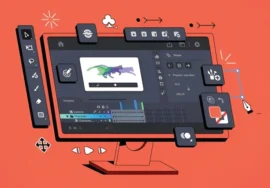
The Impact of Artificial Intelligence on 3D Design is significant.
Artificial Intelligence (AI) is quickly changing industries globally, and 3D design is no different. This powerful technology is revolutionizing the way designers create, iterate, and visualize their ideas, opening up new possibilities and accelerating innovation.
Understanding the basics of AI in 3D Design is important.
At its core, involving the application of machine learning algorithms to analyze and interpret vast amounts of data, AI in 3D design operates. Images, CAD models, or even sketches can be included in this data. By training these algorithms on extensive datasets, AI systems can master the art of recognizing patterns, generating new designs, and automating complex tasks.
Key Areas of Impact
- Generative Design:
- Automated Design Exploration: AI algorithms can generate countless design variations based on specific parameters, such as material constraints, manufacturing methods, and performance requirements. This empowers designers to explore a wider range of possibilities and identify optimal solutions.
- Biomimicry: AI can analyze the structures and functions of natural organisms to inspire innovative designs. By studying the intricate details of nature, designers can create more efficient and sustainable products.
- Real-time Rendering and Visualization:
- Photo-realistic Rendering: AI-powered rendering engines can produce stunningly realistic images and animations in real-time. This enables designers to iterate quickly on their designs and make informed decisions.
- Interactive Visualization: AI can create immersive virtual and augmented reality experiences, allowing users to interact with 3D models more intuitively and engagingly.
- Automation of Routine Tasks:
- Model Cleanup and Optimization: AI can automate tasks like removing errors, smoothing surfaces, and optimizing models for 3D printing or other manufacturing processes.
- Texture Mapping and Material Assignment: AI can automatically apply textures and materials to models, saving designers time and effort.
- Predictive Design:
- Predicting User Preferences: AI can analyze user data to predict preferences and trends, enabling designers to create products that resonate with their target audience.
- Predicting Product Performance: AI can simulate the performance of products under various conditions, helping designers identify potential issues early in the design process.
Benefits of AI in 3D Design
- Increased Efficiency: AI can automate repetitive tasks, freeing up designers to focus on more creative aspects of their work.
- Enhanced Creativity: AI can generate new ideas and inspire innovative solutions, pushing the boundaries of design.
- Improved Accuracy and Precision: AI algorithms can detect and correct errors, ensuring that designs are precise and accurate.
- Faster Time to Market: AI can accelerate the design and prototyping process, reducing time to market for new products.
- Reduced Costs: AI can lower costs by streamlining workflows and minimizing errors.
Challenges and Considerations
While AI offers significant benefits, there are also challenges to consider:
- Data Quality and Quantity: AI models require high-quality and diverse datasets to train effectively.
- Ethical Considerations: AI algorithms can perpetuate biases present in the data they are trained on. It is crucial to ensure fairness and inclusivity in AI-powered design tools.
- Designers will need to acquire new skills to work effectively with AI tools.
The Future of 3D Design with AI
The future of 3D design is bright, with AI poised to play a pivotal role. As AI technology continues to advance, we can expect to see even more groundbreaking applications in the field. From personalized design experiences to the creation of entirely new forms of art and architecture, the possibilities are endless.
Specific Future Trends
- Real-time Collaboration and Remote Work:
- AI-powered tools can facilitate seamless collaboration between designers, engineers, and clients, regardless of their physical location.
- Real-time updates and feedback can be shared across teams, accelerating the design process.
- AI-Driven Material Science:
- AI can analyze material properties and predict their behavior under different conditions, leading to the development of innovative materials with tailored characteristics.
- This can revolutionize industries like aerospace, automotive, and construction.
- Ethical AI and Responsible Design:
- As AI becomes more sophisticated, it is essential to address ethical considerations, such as bias, privacy, and transparency.
- Designers will need to be mindful of the potential impact of their AI-powered designs and ensure that they are used for good.
- AI-Assisted Design Education:
- AI can personalize learning experiences for students, tailoring educational content to their individual needs and learning styles.
- AI-powered tools can also provide real-time feedback on student work, helping them to improve their skills.
Conclusion
Integrating AI into 3D design is transforming the industry, opening up new frontiers of creativity and innovation. By embracing AI and leveraging its potential, designers can create more efficient, sustainable, and aesthetically pleasing designs.
As we move forward, it is crucial to balance technological advancement and human ingenuity. By combining the power of AI with the unique perspectives and problem-solving abilities of human designers, we can shape a future where technology and creativity coexist harmoniously.





